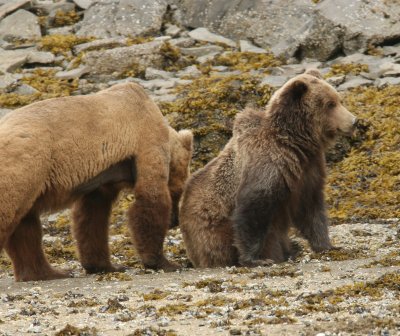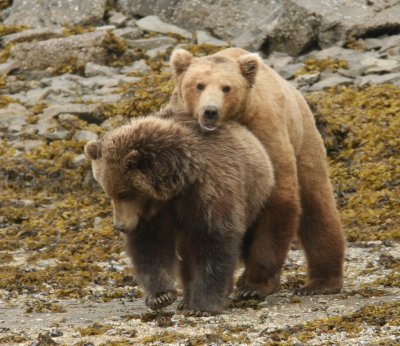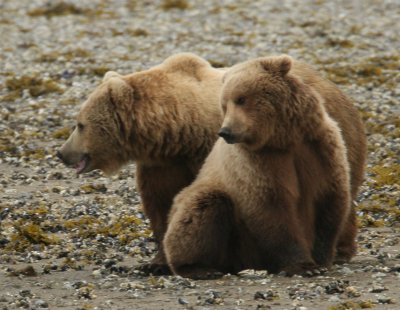

 Share This Page
Share This Page| Home | | Sailing | | Alaska 2007 | |  |  |  Share This Page Share This Page |

Copyright © 2007, P. Lutus. All rights reserved. Message Page
(double-click any word to see its definition)

Phase 1: The dance. She pretends not to be interested, but remains close by. There's lots of circling and posturing.
|

Phase 2: The first close approach. Can we talk?
|

Phase 3: The all-important exploration phase. Because of the supremely sensitive noses of bears, they gather vast amounts of information in a few seconds.
|

Phase 4: Dominance display. The male applies direct persuasion (with a firm grip on the female's cheek).
|

Phase 5: The actual mating. This might take an hour, which may explain the exhausted look on the male's face.
|

Phase 6: Sometimes, after an initial exploration, a male bear will lose interest ...
|

Phase 6: ... and the female will leap toward him and try to bite his head off.
|
I considered a number of different euphemistic titles for this page, but in the end I decided to just say it. This season, I saw more bear sex than I have seen in my 30 years of encountering bears in the wild. And, for reasons that will become obvious, I am not going to reveal when or where I saw this activity. There are too many people who read my pages, find out when and where, then visit the same places in fast, noisy boats that scare the bears away.
First, when studying wildlife, scientists are taught to avoid assuming a priori that animal behavior is anything like human behavior. This is an error called "anthropomorphizing," a fancy word meaning "interpreting animal behavior as though it is human behavior."
We shouldn't assume that animals act like humans, but sometimes they show human-like behavior, and the comparison is inescapable. If the correlation exists, it isn't a priori, it's a valid observation. And bear mating behavior is in some ways shockingly like that of humans.
Okay, I've set out the basis for my observations (don't assume, but let the evidence speak for itself). I break bear mating behavior into five phases, with an optional sixth phase that is sometimes seen under particular circumstances, and that led to the above emphasis on anthropomorphizing as a pitfall of wildlife observation. Here are the phases and descriptions:
It is with regard to item (6) above that I cautioned myself again and again about anthropomorphizing, about drawing parallels with human behavior without good reason. But I kept seeing the same sequence of events until I was forced to the conclusion that there is some degree of similarity between human and bear sexual behavior.
Based on this year's observations, it seems that if a male bear should approach a female and spark her interest, explore a bit, and then decide to forget the whole thing, he is taking his life in his hands. Just like with a woman.
The pictures on this page are mostly of a mature mating couple (not to suggest that bears choose the same partner year after year), bears not inclined to fight with each other or with competing bears, and I chose this image set for exactly that reason — e.g. one issue at a time. But these images are not typical — it is much more likely that several male bears will fight until one of them has exhausted the others and driven them away from the females, at which point that so-called "alpha male" will have the pick of the females, if only for a while.
Without revealing too much about the circumstances under which these pictures were taken, I normally enter a bay where I know bears congregate, and stay several days at anchor, well away from shore, so the bears get accustomed to my presence and forget about me. I also try to avoid making too much noise. Bears are rather nearsighted, so a quiet boat at anchor, several hundred yards from shore, is quickly forgotten. This allows me to get some very candid photographs with my most powerful lens.
But in articles from prior years I have been more specific about locations and times, and now there are an increasing number of fast, noisy boats that approach bears much too closely, to let people with snapshot cameras get decent pictures. The bears react to this intrusion by leaving the area. It is not atypical for a fast boat to enter the bay I am in and closely approach one bear after another, until all the bears have left.
This is an issue of style, not rights. I don't have any special right to be there that abrogates another's rights, and the fast aluminum boats certainly have a right to be there. I get better pictures than the average visitor, but I'm just one person, and I don't pay a tour guide or rent a place on a small, crowded boat, so I am not a matter of great importance to the tour operators, except to occasionally tell them where the bears are hanging out.
I want to touch on what bears might discover with their noses during phase (3) above, the olfactory exploration. As it turns out, we humans have recently discovered something about ourselves that is closely allied with this. It seems if we find that a potential sexual partner has an agreeable smell, this often means they have an immune system that complements our own. That means the offspring of such a match may have the advantage of two immune systems that differ in a complementary way, meaning they may possess a combined defense against pathogens that represents a favorable mix of the parents' individual defenses. This, in turn, means how a woman uses her nose to choose among men may be tied into a very important genetic trait.
This idea is a relatively new and interesting theory in reproductive biology. One difference between people and bears is that male bears' noses work just fine as they get older, while the noses of human males tend to expire long before those of women, which means women remain more reliant on their sense of smell than men are as they both get older. I mention this only to remind women that men are not necessarily being refractory about things that stink. They may genuinely not be able to smell it. This excuse doesn't carry over to bears.
The article linked above suggests that it's women who decide things based on smell, not men. The latter don't seem to care one way or the other. Based on the pictures on this page, this might suggest that bears are running a different game plan, until one remembers it's female bears who do the choosing, not males, all appearances to the contrary.
What I really cannot understand is how bears smell anything other than themselves. They usually stink to high heaven. I once saw a bear get in the water, swim across a bay, get out of the water, shake himself off, and at that point he smelled worse than when he got in. Because the human olfactory sense is so primitive, we don't have a particularly rich vocabulary for smells. Consequently I may have a hard time explaining what a bear smells like. Okay, imagine being locked in a closet with 1000 pairs of filthy gym socks. Or imagine smelling inside a Russian horse doctor's valise.
Well, I tried.
| Home | | Sailing | | Alaska 2007 | |  |  |  Share This Page Share This Page |